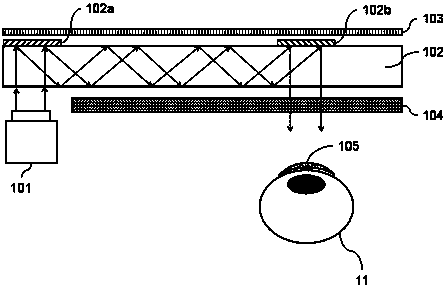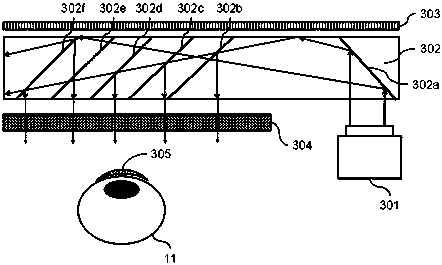Near-eye display device based on polarization contact lens
A contact lens and near-eye display technology, which is applied in the field of wearable display, can solve problems such as FOV loss, overall hardware impact on user experience, and human eyes being far away, so as to improve user experience and display effect
- Summary
- Abstract
- Description
- Claims
- Application Information
AI Technical Summary
Problems solved by technology
Method used
Image
Examples
no. 1 example
[0030] refer to figure 1 , the near-eye display device based on polarized contact lenses shown in this embodiment includes:
[0031] Micro projector 101: for projecting images;
[0032] Waveguide 102: used to fold the optical path, with at least two diffraction gratings or reflective layers on the surface or inside for the incoupling and outcoupling of light, and the expansion of the exit pupil;
[0033] Polarizer 103: used to filter light, only allowing light with a specific polarization direction to pass through;
[0034] Polarization rotator 104: used to change the polarization direction of light;
[0035] Polarized contact lens 105: used for light filtering and vision correction, only allows light of a specific polarization direction to pass through, and its diopter depends on the wearer's vision;
[0036] The near-eye display device can be a monocular display or a binocular display.
[0037] Preferably, the micro-projector 101 in this embodiment includes one or severa...
no. 2 example
[0043] refer to figure 2 , the near-eye display device based on polarized contact lenses shown in this embodiment includes:
[0044] Micro projector 201: for projecting images;
[0045] Waveguide 202: used to fold the optical path, with at least two diffraction gratings or reflective layers on its surface or inside for the incoupling and outcoupling of light, and the expansion of the exit pupil;
[0046] Polarizer 203: used to filter light, allowing only light with a specific polarization direction to pass through;
[0047] Polarization rotator 204: used to change the polarization direction of light;
[0048] Polarized contact lens 205: used for light filtering and vision correction, only allows light of a specific polarization direction to pass through, and its diopter depends on the wearer's vision;
[0049] The near-eye display device can be a monocular display or a binocular display.
[0050] Preferably, the micro-projector 201 in this embodiment includes one or sever...
no. 3 example
[0056] refer to image 3 , the near-eye display device based on polarized contact lenses shown in this embodiment includes:
[0057] Micro projector 301: for projecting images;
[0058] Waveguide 302: used to fold the optical path, with at least two diffraction gratings or reflective layers on the surface or inside for the incoupling and outcoupling of light, and the expansion of the exit pupil;
[0059] Polarizer 303: used to filter light, only allowing light with a specific polarization direction to pass through;
[0060] Polarization rotator 304: used to change the polarization direction of light;
[0061] Polarized contact lenses 305: used for light filtering and vision correction, only allow light in a specific polarization direction to pass through, and its diopter depends on the wearer's vision;
[0062] The near-eye display device can be a monocular display or a binocular display.
[0063] Preferably, the micro-projector 301 in this embodiment includes one or sever...
PUM
 Login to View More
Login to View More Abstract
Description
Claims
Application Information
 Login to View More
Login to View More - R&D
- Intellectual Property
- Life Sciences
- Materials
- Tech Scout
- Unparalleled Data Quality
- Higher Quality Content
- 60% Fewer Hallucinations
Browse by: Latest US Patents, China's latest patents, Technical Efficacy Thesaurus, Application Domain, Technology Topic, Popular Technical Reports.
© 2025 PatSnap. All rights reserved.Legal|Privacy policy|Modern Slavery Act Transparency Statement|Sitemap|About US| Contact US: help@patsnap.com



